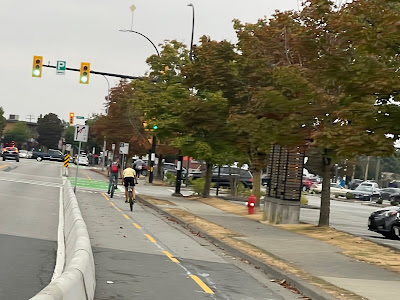From time to time, I get questions from community members asking why Langley City is investing in cycling infrastructure and how it fits into the bigger picture of enabling people to move around in Langley City and our region. I wanted to expand on this over a few posts.

|
| Young people cycling on Douglas Crescent |
The priority transportation investments in Langley City are to make walking and cycling safe and inviting. This is coupled with the regional focus on building fast, frequent, and convenient transit, including building SkyTrain to Langley City. But why?
There are four reasons.
First, as our population grows, we need to be more efficient with our transportation network as we don't have the space or money to widen roads in Langley City and many other parts of our region. Widening roads in urban areas is a destructive process as well. A road with generous sidewalks, protected cycling lanes, and bus lanes can handle an order of magnitude more people per hour than a conventional road, as people walking, cycling, or taking a bus use less space. As more people walk, cycle, and take transit, they drive less, reducing congestion. This frees up road space for tradespeople and commercial traffic.
The second reason is that it offers more cost-effective travel options. Life is expensive, and many households own more than one car. The Canadian Automobile Association has a car ownership cost calculator. Owning and operating a car costs about $10,000 per year in BC. It is even more if you own an SUV or pickup. When people have safe and convenient walking, cycling, and transit options, households could go from two or three cars to one car, which puts significant money back into people's pockets.
The third reason is car ownership's health costs. It is the direct link between high speeds, traffic volumes and increased crashes that cause injury and death, the direct link between air and noise pollution and its negative impact on human health.
The final reason is the environmental impacts of GHG emissions and battery production. The fewer cars on the road, the better it is for the environment.
Focusing on walking, cycling, and transit helps more people get where they need to go, puts significant money back into their pockets, improves their health, and cleans up the environment. This is why we are focusing on this in Langley City.
In my next post, I'll discuss how this will look on the ground in Langley City.
As a note, walking includes using mobility assistance devices. We need to ensure that as we build out walking infrastructure, it is universally accessible to all people.

No comments:
Post a Comment
All comments are moderated.